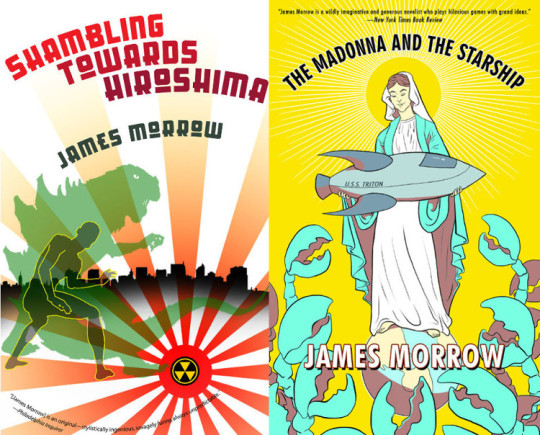James Morrow’s THE ASYLUM OF DR. CALIGARI is well written and inventive
Reviews keep rolling in for James Morrow’s pithy commentary on the power of art and the folly and hysteria of war, THE ASYLUM OF DR. CALIGARI.

For POPVERSE, Megan Leigh enjoys the book.
Adapting one of the
most iconic silent films into a new SF novel sounds like a bizarre
idea – or at least it did to me. But then again, reboots seem to be
all Hollywood can manage these days, so why shouldn’t we see the
same thing happening in novels? Despite my cynicism to this recycling
of old ideas, I actually thoroughly enjoyed THE ASYLUM OF DR.
CALIGARI. Morrow riffs on the prose style seen in classics such as
FRANKENSTEIN, THE STRANGE CASE OF DR JEKYLL AND MR HYDE, and THE
PORTRAIT OF DORIAN GREY while embracing Hammer Horror tropes. The
novel effectively transports us into a world of 19th-century gothic
fiction while maintaining contemporary sensibilities around plot and
characterisation.
<snip>
Morrow blends the
gothic prose style with camp horror all while retaining a feeling
historical accuracy – in so far as the contextual setting is
concerned (not the fantastical aspects – at least, I don’t think
that the war was bolstered by sorcerous means!). If you didn’t know
THE ASYLUM OF DR CALIGARI was published in 2017, you’d be forgiven
for thinking it was written not long after WWI. The historical
context is used to perfection, with name-drops of real life events
and people in a way that shows the author knows his stuff but without
intruding on the story more generally. And Dr Caligari’s supposed
feud with rival Freud is great fun.
<snip>
While the novel does embrace the overt silliness of this kind of gothic horror, it also finds depth in its philosophical approach to the subject matter. The story explores concepts of psychology, psychopathy, profiteering, passion, art, and more. The often slapstick-tinged horror hides a deep and complex underbelly of philosophical exploration. And as such, readers can enjoy the book on either level. If you aren’t interested in delving into the cerebral territory, there’s plenty of surface enjoyment to be had from the gothic horror tale.
Verdict: So thoroughly enjoyable it almost convinces me that the film industry would be justified in remaking the Hammer Horror classics. Well written, inventive, and a great throwback to classics of the genre.

A PROGRESSIVE ON THE
PRAIRIE praises the novella.
Most people probably
don’t start pondering the power of art after seeing the classic
German silent film THE CABINET OF DR. CALIGARI. But then author James
Morrow isn’t your average person. After all, he spent the 1990s
“killing God” in THE GODHEAD TRILOGY. A self-described
“scientific humanist,” Morrow’s last several novels explored
the scientific worldview through the perspectives of the struggle
between science and superstition in the early 17th century, genetic
engineering and ethics, and evolutionary theory.With his new book,
THE ASYLUM OF DR. CALIGARI, Morrow unmistakably moves from science to
the humanities aspect of the definition of humanist. Morrow, who made
8mm and 16mm films in high school and college, uses the 1920 German
silent horror film as inspiration and a foundation for the book.
<snip>
THE
ASYLUM OF DR. CALIGARI is an inventive homage to and extrapolation of
concepts in THE CABINET OF DR. CALIGARI. At less than 200 pages, it’s
also a pithy commentary on the power of art and the folly and
hysteria of war.
At CIVILIAN READER, James Morrow interviews himself.
Several prepublication reviews of your new novella note that it’s “inspired” by the famous German Expressionist film THE CABINET OF DR. CALIGARI. Must a reader have seen that 1920 silent movie to appreciate your book?
I always wanted my use of the Caligari mythos to stand on its own, wholly independent of the movie. The basic narrative, a satire on war profiteering, has nothing to do with Robert Wiene’s celebrated cinematic experiment. That said, a familiarity with THE CABINET OF DR. CALIGARI will help readers to get some of my book’s references and allusions. I suppose my project is somewhat like the game Charles Frazier played in COLD MOUNTAIN with THE ODYSSEY and John Updike played in ROGER’S VERSION with THE SCARLET LETTER.

You
mentioned SHAMBLING TOWARDS HIROSHIMA, which, like THE ASYLUM OF DR.
CALIGARI, incorporates quite a bit of motion picture lore.SHAMBLING
turns on the premise that in 1945 the U.S. Navy has bred a generation
of Godzilla-like, city-stomping monsters, and the hero, reminiscent
of Lon Chaney, Jr., has to put in a lizard suit and demonstrate the
new weapon’s awesome powers before a Japanese delegation (who will
them presumably persuade the emperor to sue for peace).In
retrospect, it seems that SHAMBLING TOWARDS HIROSHIMA, THE MADONNA
AND THE STARSHIP, and THE ASYLUM OF DR. CALIGARI constitute an
informal trilogy exploring the intersection of popular culture and my
philosophicopolitical obsessions. MADONNA is about the early days of
television, when most of the original programs were live broadcasts.
My hero, who writes a children’s show reminiscent of SPACE PATROL,
finds himself obligated to frantically rejigger a Sunday morning
religious program, making it seem blasphemous and irreverent.
Otherwise my alien antagonists, “logical positivists from outer
space” who resemble bipedal blue lobsters, will exterminate the
show’s audience (two million strong) in the name of their
nihilistic hyper-rationality.Is
“philosophicopolitical” a word?It
is now.
Morrow applied THE PAGE 69 TEST to THE ASYLUM OF DR. CALIGARI.
As
a writer, I have always been as excited by the medium of theater as
by prose fiction. Over the years I’ve composed quite a few one-act
comedies, and I would perhaps call myself a playwright manqué. When
I ponder my favorite non-Morrow novels, I’m content simply to revel
in their existence, but when it comes to “the theater of ideas,”
I find myself wishing I’d written RED NOSES (Barnes), ANGELS IN
AMERICA (Kushner), BECKET (Anouilh), THE ROYAL HUNT OF THE SUN
(Shaffer), and MARAT/SADE (Weiss).Because
theater is for me a road not taken, it’s not surprising that page
69 of my new novella is a dialogue exchange.
For more info on THE ASYLUM OF DR. CALIGARI, visit the Tachyon page.
Cover by Elizabeth Story
For more info on SHAMBLING TOWARDS HIROSHIMA, visit the Tachyon page.
Cover by Ann Monn
For more info on THE MADONNA AND THE STARSHIP, visit the Tachyon page.
Cover and design by Elizabeth Story
